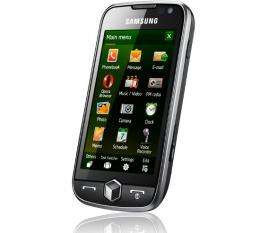Samsung's Omnia II smart phone works but lacks punch

The Samsung Omnia II smart phone with Windows Mobile 6.5 on Verizon Wireless is as dependable and exciting as a McDonald's burger.
You know what you're getting, it fills a need and it's sort of tasty if you don't expect too much.
But when you glance over and see your neighbor gorging on a Motorola Droid on the same network, you're going to feel a rumble of indigestion.
Omnia II's failings have nothing to do with its excellent hardware.
Rather, the sour taste is due to the clunky and cumbersome Windows Mobile operating system that Samsung tries valiantly to conceal.
The most impressive feature of the Omnia II is the screen.
At 3.7 inches, it's a bit larger than the iPhone's 3.5-inch screen and equal in size to the Droid's, and the resolution is just a hair below that of the Droid (800x480 vs. 854x480).
The Omnia II is bright, sharp and easy to look at. The large screen makes it simple to view expansive Web pages and scan numerous e-mails at a time (after you shrink down the oversize default font).
The 5-megapixel camera is among the best you'll find on a phone, and it even shoots passable video.
From there, though, navigating the software is a chore. The default Windows Mobile interface (even the latest 6.5 model) is an anachronism, aimed at the PDA market of five years ago, when a stylus was acceptable for interacting with a touch screen.
But the iPhone made finger-based systems standard, and Samsung tried to give WinMo 6.5 a face lift with its proprietary TouchWiz 2.0 interface.
The upgrade mostly works, but it feels inconsistent and, in some cases, pointless.
For example, to access various entertainment and media apps on the phone, Samsung has created a rotating 3D cube that you spin with your finger.
Each side of the cube is the start button for games or photos or videos.
But the interface is jerky and responds to only about half of your finger gestures, and basically just makes everything take a couple seconds longer than it should.
Fortunately, you don't have to use the cube. But it's an unnecessary and annoying innovation.
Also, exiting programs and going back a screen is often frustrating. Sometimes there's a little "x" in the upper right corner that you have to tap to go back. But the x is so small you almost have to use the stylus.
Finally, the screen itself (based on older resistive technology rather than capacitive surfaces found in the iPhone, Droid, Palm Pre and other high-end smart phones) occasionally doesn't register finger swipes at all.
It's like zooming along in a sports car with an invisible ghost occasionally stepping on the brakes.
If you really have to be on a Windows Mobile device, Omnia II is probably your best choice.
But if you have freedom to pick your own phone on Verizon's network, the identically priced and much more intuitive and elegant Droid goes down much easier.
___
Pros: The Samsung Omnia II is a great piece of hardware, with a superb display and excellent camera. The TouchWiz 2.0 interface mostly masks the stench of WinMo 6.5.
Cons: TouchWiz 2.0 is better than WinMo, but not competitive with the latest versions of iPhone, Android and webOS mobile operating systems.
Bottom line: The Omnia II feels like a good phone that's not good enough to merit its $199 price (with two-year contract). I'd love to see what Samsung could do with Google's Android OS.
(c) 2010, The Dallas Morning News.
Distributed by McClatchy-Tribune Information Services.





















